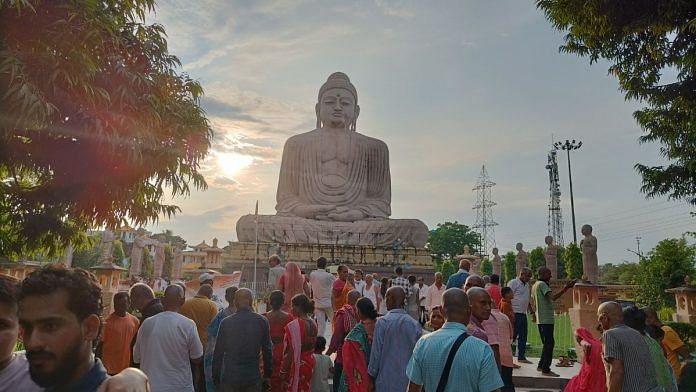Rajgir, Bihar: Naman Kumar can’t decide the best angle for flying his drone. He is looking for that perfect shot. He wanted to capture a glass bridge hanging from a hill surrounded by breathtaking views at Rajgir. The twenty-one-year-old amateur YouTuber rode 60 km on a bike from Jehanabad with two of his friends, braving rain, in search of viral content and he is not disappointed. It’s all a bid to gain more subscribers. The state’s tourism department has launched a reel-making competition for content creators, featuring prizes up to Rs one lakh.
Kumar set foot on the 130 feet-long and six-feet-wide bridge, holding his friends’ hands tightly. They laughed at him for being scared. The bridge is at a height of 250 meters from the ground and only 15 people can walk on it at a time.
“Ka gazab cheej banay dele bhai apna Bihar mein (Amazed that Bihar has this bridge),” said Kumar in awe of the bridge that was constructed in 2020 by Nail India Adventures, a Nagpur-based adventure park and rides company. The Rajgir bridge is similar to the glass bridge in China’s Hangzhou.
“It’s a thrilling experience for me to walk on a transparent glass bridge. I never thought that this could be in Bihar. Hawa mein latka ye pul chamatkar ki tarah hai (This hanging bridge is like a miracle),” said Kumar, adjusting the drone’s position using a remote. The undergraduate student has bought the drone on EMI. “I have decided to show the hidden gems of Bihar through my lens.”
Bihar has long been trying to shed its badlands image and tourism is its latest pitch to attract attention. In the absence of big industries, the state has chosen an easier way of building up revenue. Bihar does not have sun-kissed beaches, or grand temples such as those in the neighbouring UP, and is not known as a destination from where one could send out postcard images to the world. But the state is now springing surprise by trying to bring itself on the tourism map of India beyond its religious circuits — going back to its history and finally tapping into the gifts of nature. At the forefront of this shift are Bihar’s young influencers visiting local lesser-known sites and uploading videos on the internet. They are helping Biharis discover their own state. Meanwhile, policymakers are studying the tourism model of Madhya Pradesh, Maharashtra, Gujarat, Goa, Rajasthan and Uttarakhand. The state launched its first tourism policy last year.
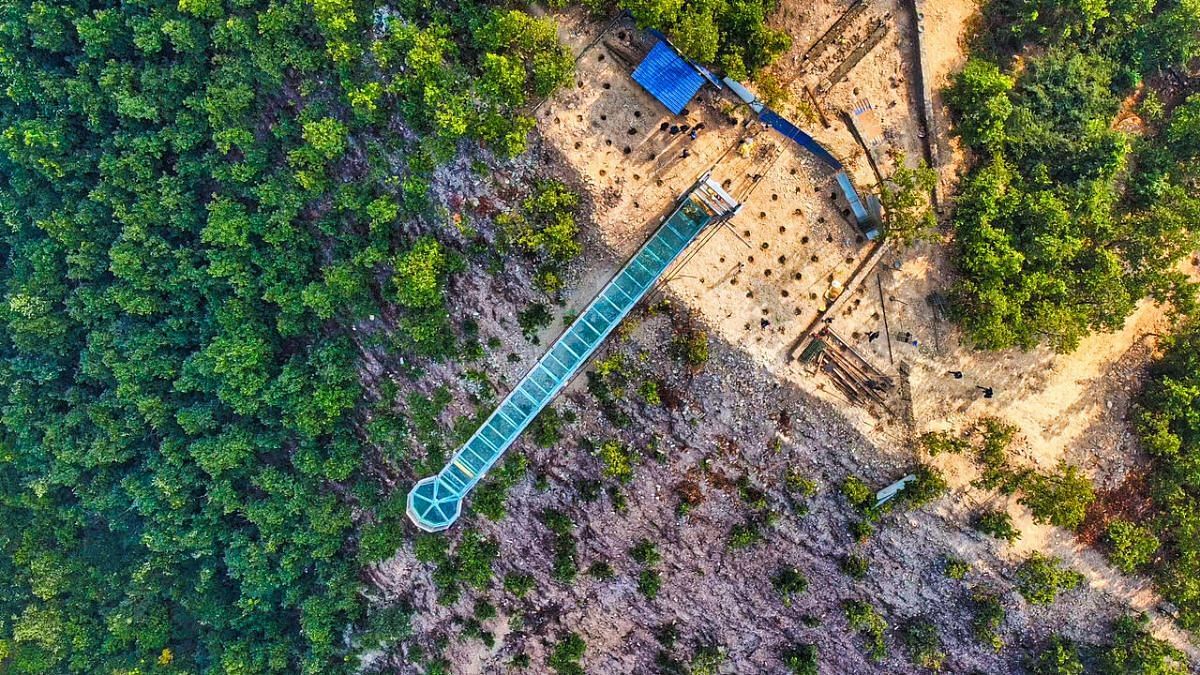
Bihar Tourism department data suggests that in the last ten years, the tourist footfall in the state increased by fourfold. In 2013, 2.23 crore tourists visited different locations of Bihar. The number increased to 8.21 crore in 2023. Though the number is one-sixth of what the neighbouring Uttar Pradesh attracts, which stood at 48 crore in 2023, it is a significant change for a state often perceived as one of the least developed regions of the country.
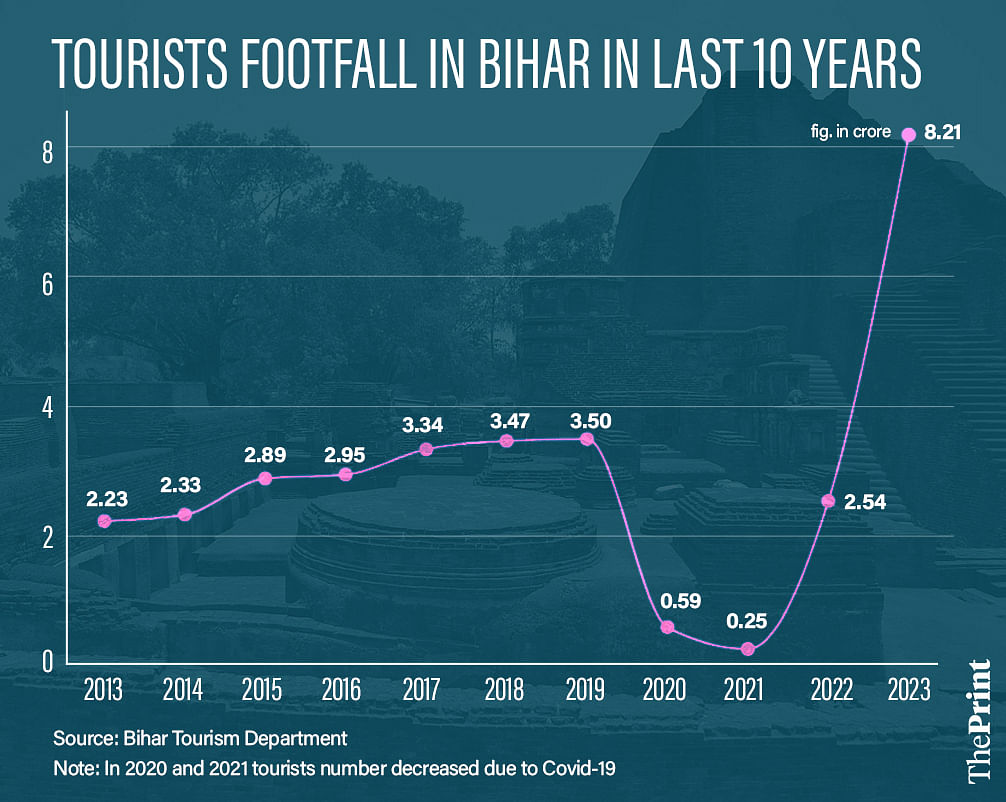
The Bihar government for the first time is working on multiple fronts to boost tourism. From introducing a dedicated tourism policy to billboard advertisements in Delhi, Mumbai and Bengaluru, signing up with social media influencers and building infrastructure on the ground, the state is sending a message to backpackers.
“Bihar has been a victim of an image and most people have formed a negative perception about the state without even visiting. Those who are coming now say that the state is not what they used to hear about,” said Nitish Mishra, Bihar’s tourism minister. He said tourism is a sector that brings in a lot of investment and the economy of many states revolves around it and despite having a lot of potential in Bihar, they could not tap it.
Various officials related to the sector admit that Bihar has been a late starter and cited poor road connectivity and electricity as major hurdles in the past. But as these bottlenecks are now resolved and the per capita income rises, the government is moving to tap the tourism market.
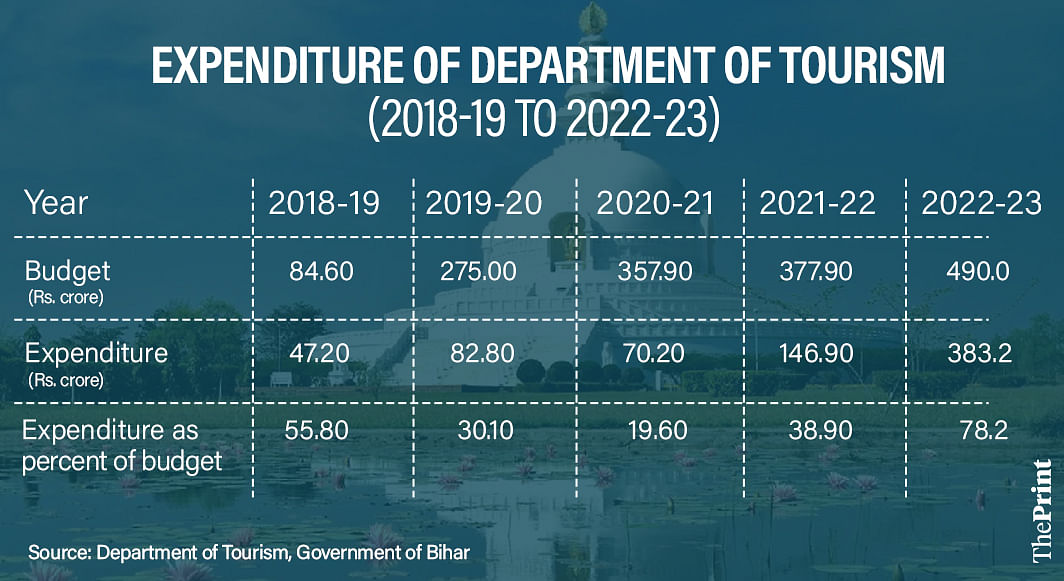
Bihar has been a victim of an image and most people have formed a negative perception about the state without even visiting. Those who are coming now say that the state is not what they used to hear about
–Nitish Mishra, Bihar’s tourism minister
“There are many places which need to be brought into the mainstream. The tourism sector will play a major role in Bihar’s GDP in the coming years. Now we are ready. We are trying to promote it so that the real Bihar, which people do not know and have never felt, can be shown,” said Mishra, filled with hope, sitting at his office in Patna Secretariat.
Also read: Nitish Kumar sends officials back to classroom. 1,000-yr-old Kaithi slows Bihar land survey
Influencer ambassadors
Armed with his drone, Deepak Kushwaha sets out on his motorcycle every Sunday in search of lesser-known scenic spots in and around Rohtas district, capturing them with his camera and putting them on Bihar’s tourism map. It began as a side hustle.
Kushwaha, who earlier worked for a diagnostic company, had his Eureka moment sometime in 2021 when he realised that online information about these local sites was missing.
Within a 100 km radius of Rohtas, lie multiple waterfalls, the historic Rohtasgarh fort and Mundeshwari temple (Kaimur). The Archaeological Survey of India dates the temple to 108 AD and has been a protected monument since 1915. Mundeshwari Temple is the oldest specimen of the Nagara style of temple architecture.

Initially, Kushwaha shot with his mobile camera but was not satisfied with the results. So he invested in a drone that cost him Rs 1 lakh.
Till about two years ago, only local people visited Sasaram’s Tutla Bhavani waterfall. The Tutla Bhavani temple near the waterfall being their attraction. Today, thousands of people come here a day. Last year, the tourism department constructed a suspension bridge for better connectivity to the waterfall.
The Manjhar Kund in Rohtas is another spot that has gained traction. According to a forest department signboard installed at the site, there was a tradition of carrying the Guru Granth Sahib to the Manjhar kund. Since the 17th century, members of the Sikh community used to stay on the Manjhar Kund for three days every year during the month of Sawan.
Kushwaha said that the roads leading to all the tourist spots are now better and connectivity is not the issue anymore. “When I started work in 2021, the road leading to the waterfalls such as Dhuan Kund and Sita Kund in Rohtas used to be muddy.”
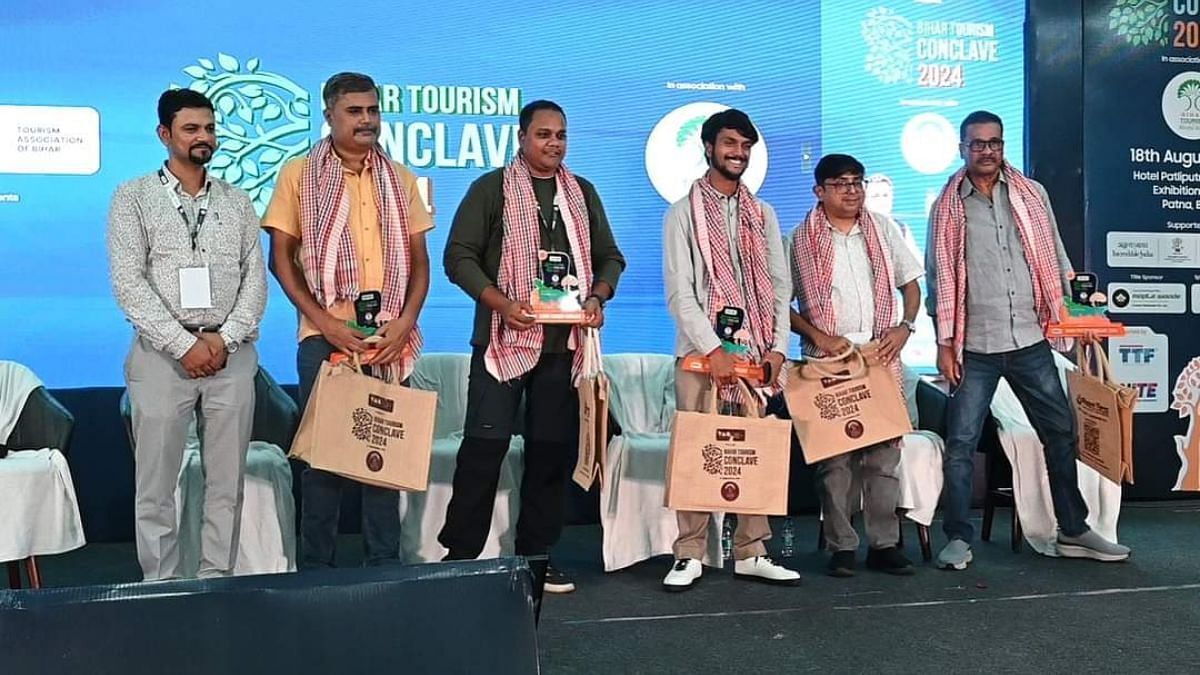
Kushwaha is now a part-time video creator and runs an Instagram page greenlifebihar. He has more than 37,000 followers. But he is still not eligible for the government’s reel making fine which requires an influencer to have more than 50,000 followers. “Most of the tourism influencers in the state who are doing good work have less than 50,000 followers, only city vloggers have this number,” he complained.
The popularity of his videos fetched him more work opportunities such as pre-wedding shoots, which is now his main source of livelihood.
On 20 July, he posted a video of Tutla Bhawani waterfall in Rohtas with the caption A wonder of Bihar. Many viewers in the comment section were curious about the location. Kushwaha claimed many tourists have come to visit Bihar after watching his videos.
Kushwaha recalled how he had to wait for three years for a single shot of Rohtasgarh fort surrounded by fog. He got the shot in August this year. A comment under the video read: “Bihari haters be like aisa Bihar ho hi nhi skta itna sundar (Bihar haters will see this video in dismay); Aap aaj nahi to kal viral hone wale ho bhai (your channel will be viral soon).”
“In the last four years, I have stopped at such places where people are afraid of going after evening.”
In 2022, Kushwaha stayed in a tent at night near the Chaurasan temple in Rohtas. There was not a single person. He recalled that the roads leading to the spot were deserted and inaccessible.
Influencers, documentary filmmakers and vloggers are unofficial ambassadors of Bihar tourism. And one-liners from the tourism department — Blissful Bihar and Bihar ko nihar — are advertising the state in Delhi and Mumbai bus stands, metros, railway stations.
“Influencers are the real heroes in promoting the tourism of the state,” admitted Mishra. In June, Mishra along with the tourism department officials had a meeting with social media influencers and RJs on different ways to expand tourism.
Ashish Kaushik is a Patna-based documentary filmmaker and is currently working with the state government on multiple tourism projects. In 2017, when he first posted pictures of tourist spots such as Manjhar Kund in Rohtas and serpentine roads of Kaimur hills, viewers said he was posting pictures from Bhutan.
“This was the beginning. The beginning of Bihar reaching out to the people,” he said, adding that people have heard about Bihar but not seen it.
I have an interest in photography. Using the skill, I have decided to break the myth about Bihar that there is nothing in the state. No one wanted to come here and visit but in just a few years, the situation has completely changed
–Ashish Kaushik, Patna-based documentary filmmaker
Kaushik is one of the early documenters of Bihar’s less exposed tourism spots. What inspired him was the humiliation he faced during his college days in Noida. It was a question of Bihari identity.
“I have an interest in photography. Using the skill, I have decided to break the myth about Bihar that there is nothing in the state. No one wanted to come here and visit but in just a few years, the situation has completely changed,” said 27-year-old Kaushik.
Basic infrastructure a decade ago, Kaushik said, was totally absent at most tourist spots in Bihar. But the situation has improved a lot now. Few people visited Valmiki Tiger Reserve (VTR) until 2018 and there was only one government hotel. But in the last five years, more than 50 hotels have come up near the reserve, which is home to 54 tigers and has surpassed its capacity of 45.
Social media outreach and support for locals
In September, the state launched the Bihar Tourism, Branding and Marketing Policy 2024, which focuses on promoting heritage sites with modern marketing technologies to highlight the state both domestically and internationally. The state will soon appoint a brand ambassador for the tourism sector. The Mera Prakhand Mera Gaurav — My Block My Pride — campaign is aimed at local people, so they can find hidden tourist locations in their localities.
Bihar Tourism handle is very active on Instagram, Facebook and X. It has a combined following of more than 2.25 lakh.
A Facebook post on the tourism department page that promotes Rajgir, features a ropeway, zoo safari and the glass bridge. “Need a quick escape from the hustle and bustle? Rajgir is the perfect destination for your next day trip or weekend retreat,” read the caption.
The Bihar tourism department is working on creating a theme song and discussions are on to shoot documentaries of tourist spots through several international channels such as History TV.
That Bihar’s tourism circuit is taking shape is also visible in the increasing number of tour operators and the packages they are offering, a concept alien to the state.
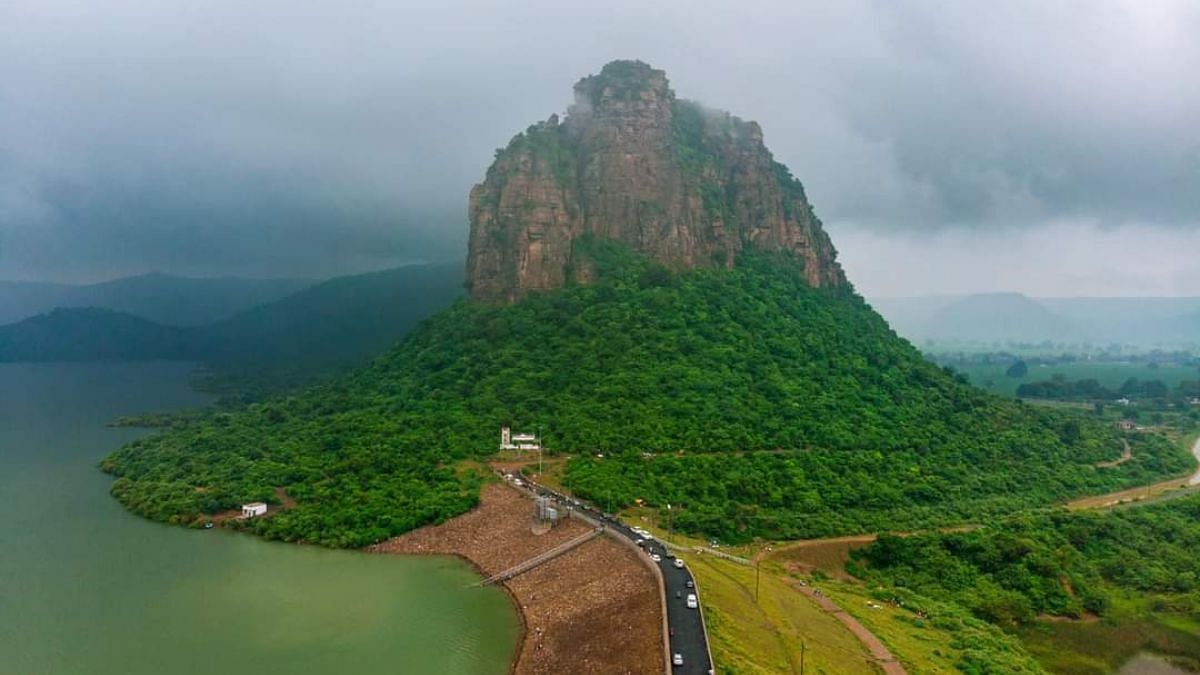
Prakash Chandra, tour operator and secretary of the Tourism Association of Bihar (TAB), said “In the last two-three years, operators have been offering weekend packages, which include cave and fort tours.” TAB has over 125 members, including tour operators, travel agents, travel bloggers, guides, photographers.
Operators are offering three nights-two days package that include a visit to the Valmiki Nagar Tiger Reserve, Vaishali, Lauriya Nandangarhm and Bettiah. A Bihar caves tour is also available for four nights and five days—covering Barabar caves, Kauwa Dol, Bodhgaya, Rajgir and Nalanda.
In August, TAB organised the state’s first tourism conclave in Patna with panel discussions on tourism growth in the state, religious tourism-strength and opportunity, inter-state tourism, tourism promotion- through a lens etc.
Also read: Is Hindi literature adapting to survive? It has more Chetan Bhagats than Omprakash Valmikis
The lost years, new policy focus
In India Today Tourism survey 2023, Bihar’s two destinations — Valmiki Tiger Reserve and Kaimur hills — won in the adventure and mountain destinations category. On 8 October, the Narendra Modi government gave green light for a tiger reserve in Kaimur — it will be the second in the state.
Earlier this year, India’s largest hospitality company Taj opened a hotel in Patna. “The opening of Taj Hotel in Patna has brought a buzz. Big brands are coming to Bihar now which was not happening earlier,” said Nitish Mishra.
Big hotel brands entering the state is another recognition of the state’s tourism boom. Last year, Hyatt opened in Bodhgaya.
The tourism secretary during RJD government said, today’s Bihar is very different from what it was 20 years ago.
“At that time, road connectivity and electricity were priorities. Tourism department was given the least attention,” he said, adding that it took more than 15 years for even Nitish Kumar to pay attention to the sector.

Last year, the Nitish Kumar government came up with a five-year tourism policy with an aim to position the state as a world-class tourism hub. The government has initiated the creation of land banks, giving capital subsidies to investors. On an investment of Rs 10 crore, the government is providing subsidies totaling Rs 3 crore. Projects owned and managed by SC/ST, EBC, third gender, acid attack survivors get 5 per cent additional subsidy.
Anyone setting up new hotels, resorts, wayside amenities, wellness centres, entertainment zones, amusement parks, camping sites is eligible for government subsidy. Land purchase cost is not included in the subsidy. There are two options for the investors, according to the proposed fiscal incentives—capital subsidy and interest subvention. New tourism units will get 100 per cent reimbursement on electricity duty, stamp duty, land conversion charge, and reimbursement of 80 per cent of SGST for five years.
“Basic infrastructure is very important along with the flow of tourists, we are working on this. The number of people coming to Bihar is increasing every year and people are leaving with good memories. And in the coming times when people will stay in Bihar for more days, then the economy here will also benefit,” said Nitish Mishra.
The tourism department has rolled out a bed-and-breakfast scheme, which allows homeowners living near 28 tourist spots across 15 districts — Gaya, Nalanda, Kaimur, Rohtas — to play host to tourists.
Big ticket projects are still going to the traditional hubs. In Vaishali, a Buddha Samyak Darshan Museum and Memorial Stupa is under construction at a cost of Rs 315 crore. In 2022, chief minister Nitish Kumar announced an airport for Rajgir. In Bodhgaya, the International Mahabodhi Cultural Centre was built in 2022 with a cost of Rs 145 crore.
“There is a need to diversify the development of tourist destinations apart from the old circuits. Special attention needs to be given to those places where tourist flow is increasing such as Kaimur, Rohtas. A lot of work still needs to be done on the ground,” said Kaushik.
Big ticket projects are still going to the traditional hubs. In Vaishali, a Buddha Samyak Darshan Museum and Memorial Stupa is under construction at a cost of Rs 315 crore. In 2022, chief minister Nitish Kumar announced an airport for Rajgir. In Bodhgaya, the International Mahabodhi Cultural Centre was built in 2022 with a cost of Rs 145 crore.
In FY25 Union Budget, Bihar received a special package amounting to Rs 58,900 crore was proposed, aiming to transform the state into an industrial, logistics and tourism hub. Comprehensive development of Vishnupad Temple Corridor (Gaya) and Mahabodhi Temple Corridor (Bodh Gaya) has been proposed. Senior officials in Bihar tourism told ThePrint that there is no movement on this as of now.
State government has projects lined up over the next two years.
The tourism department is using new technology such as foot crossing sensors at various tourist spots to collect tourist data, said Ravishankar Upadhyay, Public Relation Officer of the tourism department.
5.46 lakh foreign tourists visited Bihar in 2023, which is more than the tourist flux of Goa, which attracted 4.03 lakh foreign vistors. The tourism department includes footfalls from big fairs held in Bihar such as Sonepur Mela, Shravani Mela, Pitru Paksha Mela in the tourist data. Despite the buzz, Bihar has no data available about the revenue collection from the sector.
According to the Bihar economic survey 2023-24, the budget for tourism has increased nearly six times—from Rs 84.6 crore in 2018-19 to Rs 490 crore in 2022-23.
Last year, the government and IIM Bodh Gaya conducted a study to understand the economic output of the Sonepur fair. The study revealed the fair had a market worth of Rs 500 crore. Now, the government is considering conducting an economic study of all such fairs held in Bihar.
Upadhyay said an investment of Rs 100 crore is going to be made at Sita’s birthplace Punaura Dham in Sitamarhi district. In Gaya, a 1080-bed dharamshala is being built at a cost of Rs 125 crore. Replicas of all the major stupas of Bihar are being made near Kesaria Stupa in East Champaran at a cost of Rs 20 crore. A heritage center on the entire life of 15th century Maithili poet Vidyapati is coming up at a cost of Rs 20 crore. In Gaya, the government is planning to make replicas of the seven wonders of the world. A midway Service Plaza in Supaul is in the pipeline.
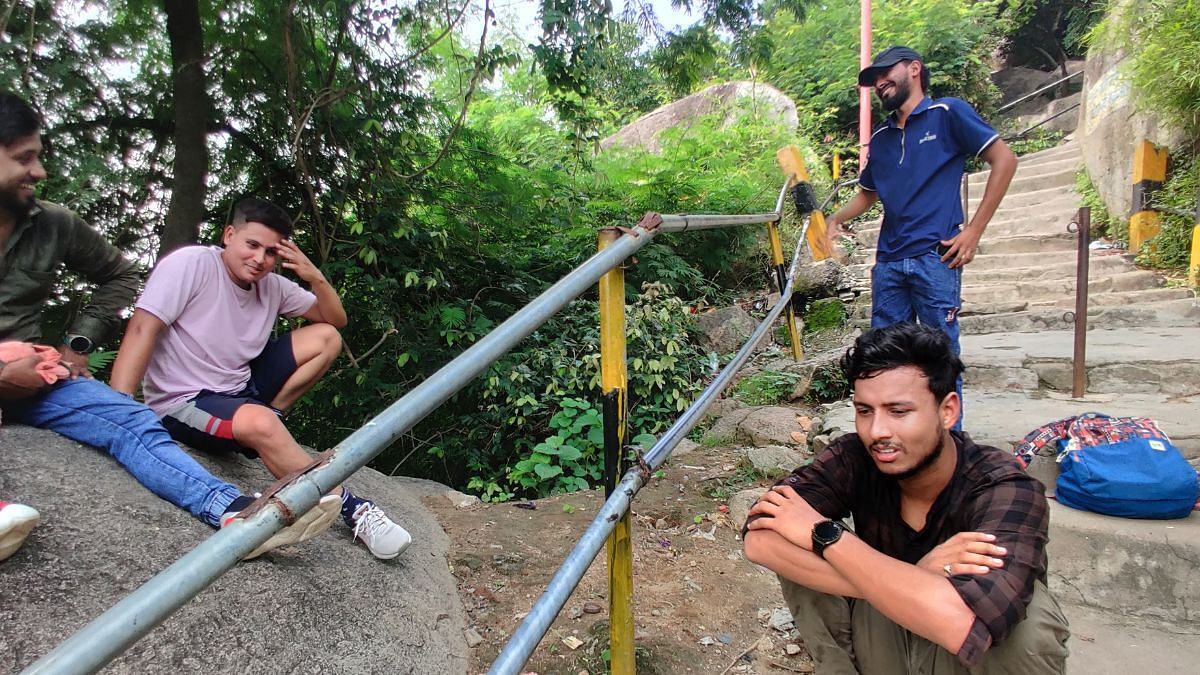
Also read: Does GI tag bring more business? Mysore silk & Jardalu mango rose, not Kannauj attar
The culture shift needed
Sumit Singh and his three friends were all very excited when they planned for a bike trip from Patna to Barabar Caves in Jehanabad. Their excitement quickly turned to dismay as the historic gateway unravelled into a disappointing experience.
The Barabar Caves are among the rare rock cut caves of India. After Singh and his friends climbed up more than 300 stairs and reached the Shiva temple situated on the top of the mountain, they were exhausted and filled with regret.
“There is no dearth of anything in this place. Here, one can see the caves, nature view along with the Falgu river, but there is not even a single shop on the way where water is available. The Bihar government is promoting tourism so much, while there is no infrastructure on the ground,” said Singh who is in his twenties.
The infrastructure gap is visible around the waterfalls located in Kaimur and Rohtas too. Both districts have more than a dozen waterfalls such as Telhar kund, Manjhar kund, Dhuan kund, Tutla Bhawani. The roads to reach there have somewhat improved in the last two years, but basic facilities are missing.
There is no dearth of anything in this place. Here, one can see the caves, nature view along with the Falgu river, but there is not even a single shop on the way where water is available. The Bihar government is promoting tourism so much, while there is no infrastructure on the ground
–Sumit Singh, a local tourist
Madhya Pradesh, a state similar to Bihar in terms of industrialisation, has projected itself as the biggest tourism hub in India to great success. It has kept and cared for its forts, its tigers’ roar from multiple national parks attracting tourists. There is a shift in culture that has been achieved over two decades. Bihar has many miles to travel.
Sumit Singh and his friends’ disappointment were not limited to the infrastructure. It’s the missing hospitality that’s more shocking. The keys to the Barabar Caves, which is an ASI protected monument, lay with an old man who had set up a kiosk on a plastic table, selling cucumbers and chana.
(Edited by Anurag Chaubey)



